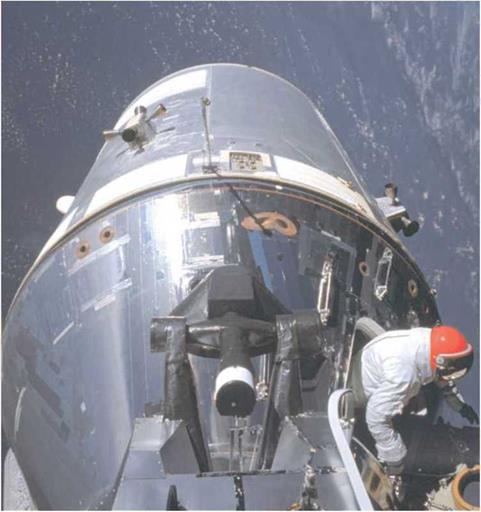A COMPLETE SYSTEM TEST: APOLLO 9
By now NASA had confidence in the Apollo CSM, but no one had yet flown inside the flimsy lander that was to take crews to the Moon’s surface. NASA ticked the D – mission box by flying the entire Apollo system, consisting of the main spacecraft and a fully configured lander, LM-3, in Earth orbit as Apollo 9. It was to rehearse all the manoeuvres that a Moon flight would require. It also marked the first time astronauts would entrust themselves to a spacecraft that had no heatshield and therefore would not be able to bring them home in an emergency, but it was a trust that would have to be gained if the LM was to take their colleagues to the Moon’s surface.
After a successful launch on 3 March 1969, the crew followed a ten-day timeline roughly similar to a lunar mission but without leaving low Earth orbit. This began with retrieval of the LM from its station on top of the S-IVB stage, one of many firsts achieved in this crammed mission. Controllers on the ground then commanded the now discarded booster to reignite its engine and leave Earth’s vicinity, as if dispatching an Apollo mission to the Moon. The spent stage eventually escaped Earth’s gravity to enter its own independent orbit around the Sun. After a number of firings of their SPS engine to set up the correct orbit, Jim McDivitt and Rusty Schweickart entered the LM, call sign Spider, and powered it up. David Scott remained behind in Gumdrop, the CSM. The names selected by the crews simply reflected the shapes of their spacecraft.
Schweickart was to venture out of the LM’s front hatch in order to test the type of
|
Rusty Schweickart’s view from the porch of lunar module Spider looking along CSM Gumdrop with David Scott working out of its side hatch on Apollo 9. (NASA) |
spacesuit and back pack that crews were to use on the Moon and demonstrate that, in the event of an unsuccessful doeking or a blocked tunnel, a crewman could make his way from one spacecraft to another by using external handrails, but this spacewalk was reduced in scope when Schweickart suffered a bout of space adaptation sickness on the day prior to his task. Managers still had little experience of this condition and allowed hint only to move out onto the LM ‘porch’ to prove the space-worthiness of the suit and back pack, while Seotl stood in Gumdrop’s hatch to retrieve experiments from the skin of his own spacecraft.
Four days into the flight, McDivitt and Schweickart sealed the tunnel between the two vehicles and undocked Spider. After a visual inspection by Scott, they fired the LM’s descent engine to move 185 kilometres away from Gumdrop and set up the conditions for a lunar-type rendezvous. After the descent stage had been jettisoned, they flew the ascent stage back to the command module, as would happen on a lunar mission, and eventually docked and transferred back to the company of Scott without difficulty.
For the remainder of the flight, the crew practised navigation techniques, made multiple adjustments to their orbit with their dependable SPS engine, and carried out experiments including multispectral photography of Earth in support of future Earth resources satellite programmes and the manned Skylab orbital workshop. Although less glamorous than the missions to come, Apollo 9 was a highly successful overture to Apollo’s climax: flying to the Moon.











